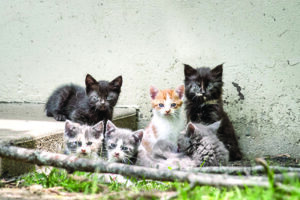By Dr. Beth Leermakers
My dogs love to walk down “kitty cat alley,” where my neighbor feeds and cares for several feral cats. The cats, apparently understanding that my leashed dogs are no threat, don’t bother to move when we approach. With the nights getting colder, I worry about the cats being outside in the elements. Read on to learn how you can help your neighborhood cats.

Photo courtesy of Vetsavers.com
Feral cats are free-roaming domestic cats who were never socialized by humans or have lived outdoors for so long that they have reverted back to a wild state. These cats may have been born into the wild, or they may be family pets who got lost or were dumped outside by their previous owners. Feral cats live outdoors, hunting for food or relying on people to provide food and clean water.
Some people complain that feral cats are a nuisance, making a lot of noise when they’re mating or fighting to protect their territory. Spaying and neutering them takes care of these problem behaviors. Furthermore, an established, vaccinated and sterilized colony will prevent other (unvaccinated) stray and feral cats from moving into the neighborhood, reducing cat fights and exposure to unvaccinated cats. Referring to them as “free living” or “community” cats removes the stigma associated with “feral” or “wild” cats.
While some people believe that cats attract rodents because of uneaten cat food, the opposite is true. Rodents avoid cats and other predators. When mice detect certain proteins (Mups) in feline saliva, they react with fear. Community cats can minimize rodent problems in neighborhoods and are a non-toxic, green alternative to chemical pest control. Community cats protect us from the diseases and structural damage to houses (such as chewed wires creating a fire hazard) that rats and mice can cause.
Some cities — including Chicago, Washington D.C., and New York — put feral cats to work controlling rodents. One study found that cats were no match for super-sized New York rats, killing only two rats at a Brooklyn waste management facility during the 79 day study period. In the cats’ defense, New York’s brown rats weigh about 330 grams, approximately 10 times more than an average mouse. When faced with these giant critters, the cats (wisely) choose smaller, less challenging prey such as birds or mice. Cats presumably fare better against smaller suburban rodents. Furthermore, cats’ pheromones are often enough to keep the rodents away.
How Can You Help Community Cats?
Provide shelter. A dedicated shelter protects outside cats from cold and/or rainy weather and keeps them close to home, so they won’t venture into neighbors’ yards. If they have a cozy shelter, they’ll be less likely to hunker down where they’re unwanted, such as under porches, or unsafe (under car hoods). A cat shelter should be 2 feet by 3 feet, and at least 18 inches high, with a small (6” – 8” wide) door that is only big enough for cats. The shelter should be just big enough for three to five cats to huddle together. Sturdy wooden shelters are ideal. Lightweight plastic storage tubs or Styrofoam coolers provide less protection from predators but are better than nothing.
Use straw for bedding. Straw makes the best insulation and bedding, because it resists moisture and keeps the shelter warm. You can buy straw at feed stores or Tractor Supply. Never use hay, blankets or towels — because they retain moisture, making the shelter wet and cold. Blankets and towels can also get moldy and even freeze, making them useless.
Become a caretaker. Caring for free-living cats is a big responsibility, just like caring for your own pets. You must provide food and veterinary care and commit to caring for the cats for the rest of their lives. On their own, feral cats only live about two years. With regular care (adequate shelter and daily feedings), they can live up to 10 years. When you go on vacation, or if you move, you need to make arrangements for someone else to take over feeding them.
Caretakers provide these services for their community cat charges:
Trap, Spay/Neuter, and Return (TNR). Spaying and neutering is essential to prevent a small colony from growing rapidly. Fixing free living cats also decreases their chances of developing certain cancers and reduces aggression, ending those blood-curdling fights. When you see a free living cat with a tipped ear (i.e., the tip of one ear is surgically removed), that means the cat has been altered. Incorrect trapping of community cats can lead to injuries to both you and the cat, so you should consult an experienced trapper for guidance. Spay Neuter Network will spay/neuter a feral cat, give him a rabies vaccination, and tip his ear for $30 (for Dallas residents). These services are free for Fort Worth residents. Visit spayneuternet.org/feral-cats/ for details.
Veterinary care. At a minimum, community cats need a rabies shot (required by Texas law) that must be boosted on a set schedule. Some caretakers also give their cats heartworm preventatives and vaccines to prevent feline-specific diseases such as feline leukemia virus. You also need to monitor your kitties for health concerns, arranging veterinary care or humane euthanasia when needed.
Daily food and water. You should feed the cats at the same time every day, so they expect and rely on a schedule. Otherwise, they will venture out in search of food, which can be dangerous in extremely cold weather. If you live in an area with coyotes and other predators, don’t leave the food out overnight. Outdoor cats will need extra calories and fat during cold winter months to maintain their energy requirements. A dry kitten formula is an excellent source of extra calories and balanced nutrition.
